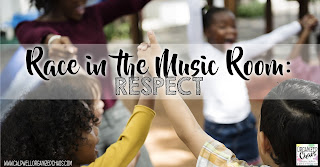I'm trying some new ideas for recognizing Music In Our Schools Month this year, and one of them is a March Madness- style bracket for songs from a variety of genres. I'm excited to use this as a way to generate thought and discussion around a wide range of genres among students and the broader school community, and it ties in perfectly with this year's theme: "All Music. All People." so I think it's the perfect time to try it out!
Of course you can do this with any songs you like! Although they will all be unfamiliar to most of my students, I tried to also pick songs that would be appealing to at least some portion of my student population rather than pick things that are so foreign that students would immediately tune it out. I do use a lot of music that is less comfortable for them in my own classes, but since I won't be there to help them know how to listen to it, I thought it would be more of a "fair fight" to choose things that they will at least be able to appreciate at some level without my input.
The basic idea is to play 2 songs over the announcements each morning and ask students to vote on which one they prefer, then gradually put the winners of each round against each other in a bracket format until we end up with one top favorite song for the school! Because we have 21 school days in March this year, I came up with this bracket so that we would have one round for each school day:
That's 24 songs that get narrowed down to 1 by the end of the month! As you can see, I had to have one round where 3 songs go against each other to make the math work out, but that will just keep it interesting towards the end, right?
I decided to choose songs that I don't think my students will be familiar with, because I don't want certain songs to have the advantage of being well-known. Some genres will definitely still be more familiar than others, of course, but hopefully it will help students be more open-minded if they don't instantly recognize certain songs.
Here's the list I've come up with for this year (in no particular order), or you can see them all in this YouTube playlist:
Of course you can do this with any songs you like! Although they will all be unfamiliar to most of my students, I tried to also pick songs that would be appealing to at least some portion of my student population rather than pick things that are so foreign that students would immediately tune it out. I do use a lot of music that is less comfortable for them in my own classes, but since I won't be there to help them know how to listen to it, I thought it would be more of a "fair fight" to choose things that they will at least be able to appreciate at some level without my input.
I don't know if this will work out, but I'm hoping to also have staff from around the district vote as well. I'm hoping to send out a simple poll they can click in their email that would make it easy for them to listen and vote- it would be interesting to see what the staff would pick compared to the students, and it would be great to involve more of the adults from around the district to raise awareness as well!























